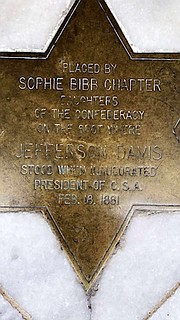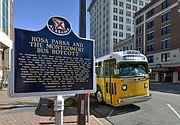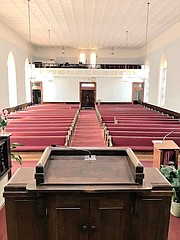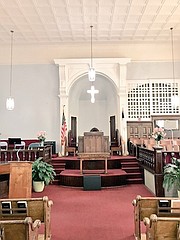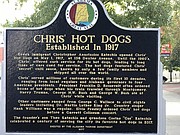11/22/2017
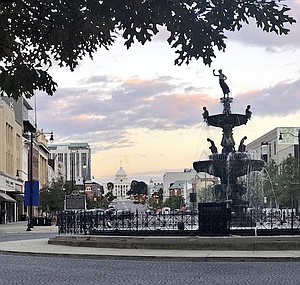
Welcome to Montgomery, Alabama, the “Capital of Dreams.” Serving as the capital of Alabama, Montgomery was once the capital of the Confederacy States of America when Jefferson Davis was sworn in at the steps of the capitol building as the president of the CSA on February 4, 1861. That was the beginning of Alabama’s long lasting American history that still prevails in the south until this day. From the welcoming citizens and good food to the rolling hills and its historic past, there is no denying that this cool capital cool city is definitely worth a visit. Join me as I take the challenge and discover a new destination, the new Montgomery!
The History
At 200 years old, Montgomery is known for being the birthplace of the Civil War and Civil Rights Movement; however, the city is also older than the state of Alabama itself. History says that Andrew Dexter, Jr. founded ‘New Philadelphia’, which is the present day eastern part of downtown. With the thought that his town would one day grow in popularity, Dexter set aside a hilltop known as "Goat Hill" as the future location for the state capitol building. New Philadelphia indeed prospered and General John Scott with his group of first settlers built a new town adjacent calling it East Alabama Town. The towns became rivals, but merged on December 3, 1819, and were incorporated as the city of Montgomery. The new city was named for General Richard Montgomery. The legacy of the towns' merger still can be seen today in the alignment of downtown streets where Court Street and Dexter Avenue meet.
The Civil War
The state of Alabama was central to the Civil War, with the secession convention at Montgomery, birthplace of the Confederacy, inviting other states to form the Southern Republic, during 1861, and develop constitutions to legally run their own affairs. Emerging from its agricultural roots in the 19th century, Montgomery transformed from the Cradle of the Confederacy to the birthplace of the Civil Rights Movement in less than a century. Two months after Jefferson Davis took his oath of office on the steps of the capitol building he sent a telegram from the Winter Building on April 11, 1861, to authorize his general to fire on Fort Sumter in Charleston S.C. That was the official start of the Civil War.
The Civil Rights Movement
Nearly 90 years after the start of the Civil War in Montgomery, the city found itself yet again at the center of attention in 1955 when Rosa Parks refused to “move to the back of the bus,” sparking the birth of the Civil Rights Movement. There is no denying that Alabama was the site of some of the most defining events of the civil rights era, transforming the state and profoundly changing America. And to think, it all began with the Montgomery Bus Boycott. What was supposed to only be one day of boycotting, nearly 30,000 African Americans participated in the bus boycott lasting for 13 months.
The leaders of the African American community, including Ralph David Abernathy, pastor of First Baptist Church who formed the Montgomery Improvement Association (MIA), coordinated future protests. Abernathy's close friend Martin Luther King Jr., the 26-year-old pastor of Dexter Avenue Baptist Church, became the president of the organization thrusting the young preacher to the forefront of the national spotlight.
Soon after came the Alabama Christian Movement for Human Rights, then the Tuskegee Fight for Voting Rights, followed by the Sit-Ins and Freedom Rides, which ultimately lead to the March on Selma that also took place on the steps of the Montgomery State capitol building. With the many lives taken and the nation shaken, the Civil Rights Movement was seen as the rise of the Black Power Movement. The hard work came with joy after President Lyndon B. Johnson signed the Voting Rights Act of 1965.
The Attractions
There is something for everyone of all ages to do in Montgomery. While visiting the city, I was lucky enough to visit some of the best historical monuments and tourist attractions. Start your tour off at the Rosa Parks Museum. Ran by Troy University, and built at the exact spot where Parks was arrested, the museum tour starts with a film about segregation in the South in the 1950s with an emphasis on the Montgomery Bus Boycott. Following the film is an animated version of a Montgomery bus, Rosa Parks’ actions and what happened to her afterward. The museum contains displays of photos, documents, and short videos of people discussing the bus boycott. I must admit that it was rather inspiring to hear first-hand stories and the conviction they had to see it through. While this was a small but very important part of the civil rights movement, I found the museum to be very well laid out and interesting. It’s a must-see.
Continuing on with museum tours, The Fitzgerald Museum offers insight to The Great Gatsby originators! The home once occupied by Scott and Zelda Fitzgerald in Montgomery for a short time was very interesting to see in person. There you will find several memorabilia items on display such as photos, letters, books and some of Zelda’s last art pieces before her tragic death. If you are at all interested in all of this and more the museum is worth a visit and it’s free admission! (We ALL love free!)
Of course, no visit to Montgomery is complete without seeing the Dexter Avenue Baptist Church and the Dexter Parsonage. Shortly after marrying his college sweetheart in Alabama in 1954, 24-year-old Martin Luther King, Jr. preached his first sermon at Dexter Avenue Baptist Church, a block from the Alabama State Capitol where Southern secessionist had formed the Confederacy in 1861. King went on to preach at this church for six years until 1960 before he went back to Atlanta to co-pastor with his father at Ebenezer A.M.E.
Also, be sure to take a tour of the state capitol building located on “Goat Hill” and if you want to get your “Honky Tonk” on stop by the Hank Williams Museum to view many of his artifacts and the death car Williams died in at the age of 29.
The Cuisine
Satisfy your appetite at one of the many delicious restaurants that Montgomery has to offer. Get your day started at Cahawba House! Opened by a brother-sister duo, this breakfast spot pays homage to everything Alabama. From the handmade buttermilk biscuits to the Conecuh sausage, you would surely be in for a treat. If you want a quick but yummy lunch, stop by Chris’s Hot Dogs! At 100 years old, this restaurant is the oldest in town. Everyone from Elvis Presley, Harry Truman, Dr. Martin Luther King, Jr., & Presidents Bush 41 & 43 have indulged in Chris’s goodness. You won’t be disappointed either.
For dinner, one of the greatest places you can dine at is Vintage Year. From dinner with friends and family to the most memorable special occasions, the Vintage Year has been an important part of Montgomery’s social scene since 1984. What began as Montgomery’s only specialty wine shop soon became a destination for gourmet lunches and dinner entrees were added and the rest is history. The Vintage Year has held the honor as one of the Capitol’s favorite dining experiences for decades with over a quarter century of stories to be told. The restaurant has served several southern governors, noted attorney Johnny Cochran, and John F. Kennedy Jr., to name just a few.
On A Personal Note:
I honestly did not know all of the history that lies in Montgomery. This city is a special gem. Many people pass by Montgomery; either on I-85 switching to I-65 on their way to and from Atlanta or just because they do not know what the city offers. This place is filled with warmth, love, history, and honor. A perfect place to visit year round, I highly urge anyone to place Montgomery, Alabama on their places to visit list. Special thanks to Meg Lewis and Dawn Hathcock of the Montgomery Area Chamber of Commerce and Michael Hicks, Vice President of Lou Hammond Group for making this wonderful trip a unique one. Visit www.VisitMontgomery.com to plan your trip today!

